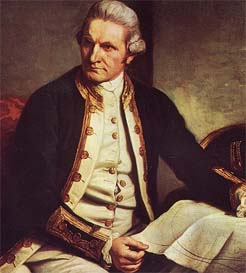Captain James Cook: England's Supreme Explorer, Mapmaker
James Cook was one of the world's most famous explorers. The Royal Navy sea captain made three voyages through the Pacific Ocean, sailing thousands of miles and employing his navigation and cartographic skills, along with a crew of nearly 100, and was the first known European contact with Hawaii and Australia's east coast. In addition, Cook and his crew were the first to circumnavigate New Zealand.
James proved an able student, excelling at algebra, astronomy, geometry, navigation, and trigonometry. These were all skills that would come in handy later for him in the endeavors that made him famous. A lover of the sea from an early age, Cook joined the Royal Navy in 1755, when he was 27. He worked his way up through the naval ranks, serving on a series of ships in various capacities. He fought in the French and Indian War (taking part in the dramatic seizure of Louisbourg and in the climactic battle on the Plains of Abraham) and, during the siege of Quebec, mapped Newfoundland and a large part of the area surrounding the St. Lawrence River. Cook’s first voyage of exploration, at the helm of a ship called the Endeavour, began in 1768. One of the express purposes of this voyage was to observe and make detailed records of the Transit of Venus that occurred in April 13, 1769. Cook and crew were in Tahiti when the Transit occurred. The crew then moved on to the secret part of their journey: Cook had with him sealed orders from the Royal Navy, with instructions not to open the orders until the Transit had finished. The orders were for the crew to carry on sailing in the Pacific, on the trail of the fabled continent of Terra Australis, which scientists were convinced existed far to the south of any known landmasses.
The crew returned to English territory, the island of Saint Helena, in 1771. They returned without losing a single man to scurvy, a very common seaborne ailment. This was a rare achievement. |
|
Social Studies for Kids
copyright 2002–2024
David White




 Cook and crew reached New Zealand in October 1769 and mapped the complete coastline. The crew then sailed west, becoming the first Europeans to see eastern Australia, on April 19, 1770. In written records, Cook listed his impressions on first seeing indigenous Australians. The sailors made landfall at what is now Botany Bay, named after the botanical specimens retrieved by the crew’s scientists. Sailing on northward from Botany Bay, the crew had to wait a bit after the ship ran aground on a shoal of the Great Barrier Reef. Repairs, done on the beach near what is now Cooktown, in Queensland, took seven weeks.
Cook and crew reached New Zealand in October 1769 and mapped the complete coastline. The crew then sailed west, becoming the first Europeans to see eastern Australia, on April 19, 1770. In written records, Cook listed his impressions on first seeing indigenous Australians. The sailors made landfall at what is now Botany Bay, named after the botanical specimens retrieved by the crew’s scientists. Sailing on northward from Botany Bay, the crew had to wait a bit after the ship ran aground on a shoal of the Great Barrier Reef. Repairs, done on the beach near what is now Cooktown, in Queensland, took seven weeks.
